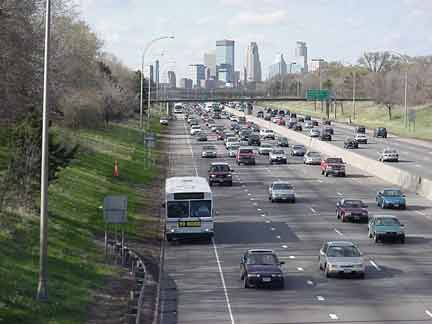 Photo from Minnesota DOT. |
Why not let buses drive on highway shoulders to get around congestion? That can be done, and it does often work, but it’s not quite as simple as putting a sign up and saying “let’s do it”.
CDOT is planning shoulder lanes on US-36 as part of the BRT project there. The original plan for US-36 was to have buses use the planned HOT lanes, but the HOT lanes are in the middle, difficult to access from buses that frequently enter and exit the highway. So shoulder lanes there will give buses the more direct lanes they need.
But why stop there? Most highways have shoulders, and a lot of them have buses. With pressure mounting to stretch dollars and improve mobility, creative ideas like putting buses on shoulders make a lot of sense.
The main complicating issue is that highway shoulders are usually too narrow and not free enough from obstructions to immediately open them up to buses. Interstate highway standards call for 9 foot shoulders, but you need at least 10 feet for a bus, and really 11-12 feet is preferable. So a typical highway shoulder will have to be beefed up in order to be used as a bus lane.
That’s a lot easier, and cheaper, than just about anything else you could do. But it’s still a construction project that has to be planned and funded.
On US-36 CDOT is incorporating 12-foot shoulders into its designs for the reconstruction that’s already happening for HOT lanes. But in places that aren’t already undergoing reconstruction, putting buses on shoulders isn’t as easy.
For safety reasons, buses are usually only permitted to go 35 miles per hour when using shoulders next to congested traffic. But that’s enough to get by the worst jams. If traffic is moving faster than that, buses just stay in the regular lanes.
Minneapolis has an extensive network of over 300 miles of shoulder bus lanes on highways. But it’s taken them over 20 years to get there. They have a continuous program that adds a few miles each year. They started with the low-hanging fruit, and have worked up to more complicated stretches.
This idea can improve bus service, draw more riders to transit, and reduce highway congestion. It’s win-win-win. But it takes planning, and isn’t free. CDOT should be commended for using it on US-36, but should also consider where else it might work.










So, did I understand that you are saying the buses on US 36 won’t use the HOT lanes in the center but instead stay on the outside lane and use the shoulders when necessary? Id so, that might be more efficient – although the right lane is always a nuisance with entering and exiting traffic slowing it down. But, if the busses are also entering and exiting at every interchange, – not a problem.
Does a stricken car still pull onto the shoulder? How does this affect the buses? Would the bus would treat it as a chicane?